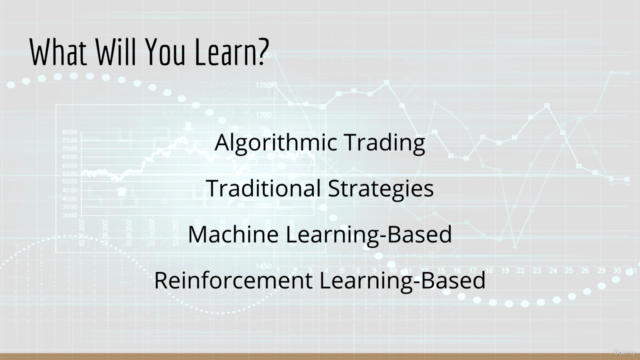Financial Engineering and Artificial Intelligence in Python

Why take this course?
🚀 Financial Engineering and Artificial Intelligence in Python: Your Ultimate Guide! 💼🤖
Course Headline: Financial Analysis, Time Series Analysis, Portfolio Optimization, CAPM, Algorithmic Trading, Q-Learning, and SO MUCH MORE!
What's in Store for You?
Have you ever pondered over the fusion of machine learning, artificial intelligence, and financial engineering? Well, wonder no more! Dive into the world where these three disciplines merge to create unparalleled analytical tools. 🌐💡
This comprehensive course will guide you through the core fundamentals of financial engineering with a machine learning edge. You'll master the essentials while exploring advanced topics that will transform your understanding of financial markets.
Essential Financial Engineering Topics:
- Exploratory Data Analysis: Uncover trends and patterns that shape financial decisions.
- Time Series Analysis: Master techniques like Moving Averages, Exponential Moving Averages, and Holt-Winters Exponential Smoothing.
- ARIMA and SARIMA: Predict future market movements with these powerful statistical tools.
- Market Efficiency: Understand the principles behind the Efficient Market Hypothesis and Random Walk Hypothesis.
- Time Series Forecasting: Learn to predict stock prices with accuracy using time series models.
- Modern Portfolio Theory: Construct efficient portfolios that maximize returns while minimizing risk.
- Efficient Frontier / Markowitz Efficiency Frontier: Identify the optimal investment allocation.
- Mean-Variance Optimization: Maximize your investment performance with this strategic approach.
- Sharpe Ratio: Discover how to maximize returns over the risk-free rate for a given level of volatility.
- Convex Optimization: Solve complex optimization problems using Linear and Quadratic Programming.
- Capital Asset Pricing Model (CAPM): Understand how to model the expected return of an investment and its relationship with the risk factors.
Delving into Machine Learning Techniques:
- Regression Models: Analyze relationships between variables and predict outcomes.
- Classification Models: Categorize data for decision-making purposes.
- Unsupervised Learning: Discover hidden patterns in data without predefined labels.
- Reinforcement Learning and Q-Learning: Develop algorithms that make decisions by learning from interactions with an environment.
VIP-Only Sections:
Unlock exclusive content on algorithmic trading, statistical factor models, and regime detection using Hidden Markov Models (HMMs). 🗝️
- Algorithmic Trading: Employ trend-following, machine learning, and Q-learning strategies.
- Statistical Factor Models: Analyze market factors to predict asset returns.
- Regime Detection: Model volatility clustering using HMMs to adapt trading strategies.
The Myth of Stock Price Prediction with LSTMs:
Discover the pitfalls of misguided AI applications in finance and learn why certain predictive models don't work as advertised. 🚫🤖
Course Structure and Order:
Before diving into this course, it's crucial to have a solid foundation in machine learning and AI. I recommend starting with my free Numpy course and reviewing the "Machine Learning and AI Prerequisite Roadmap" lecture for guidance on the order of courses to take.
Unique Features of This Course:
- Detailed Code Explanations: Every line of code is thoroughly explained, and you're encouraged to question anything that isn't clear.
- No Time Wasted: I ensure that we avoid the pitfalls of live coding sessions that can't replicate real-world coding scenarios.
- University-Level Math: Get insights into the complex mathematics behind algorithms that other courses might overlook.
Join me on this journey to master Financial Engineering and Artificial Intelligence! 🌟
With hands-on learning, detailed explanations, and a focus on understanding the underlying principles, you'll be well-equipped to tackle real-world financial problems using AI. Let's embark on this path together and transform data into profitable insights! 🚀✨
Course Gallery




Loading charts...
Comidoc Review
Our Verdict
Delivering 210 hours of knowledge in just 21 hours of instruction, this Financial Engineering and Artificial Intelligence in Python course by the Lazy Programmer is a comprehensive exploration of complex financial theories and machine learning techniques. While it boasts an impressive 4.72 global rating and over 10,000 subscribers, its steep learning curve can make it challenging for beginners without a solid understanding of advanced mathematical concepts and programming experience. Despite its minor shortcomings, this course stands out as a rare gem in the realm of financial engineering e-learning, offering valuable insights into statistical analysis, portfolio optimization, time series forecasting, and CAPM—arming you with the knowledge necessary to navigate the vast oceans of modern finance.
What We Liked
- Covers a wide range of topics in financial engineering and AI, providing a strong foundation for further studies in the field.
- In-depth exploration of important concepts such as time series analysis, portfolio optimization, and the Capital Asset Pricing Model (CAPM).
- Richly detailed lectures that explain complex formulas and theories with patience and clarity.
- Practical Python examples to reinforce understanding and enable real-world application.
Potential Drawbacks
- Steep learning curve due to heavy use of mathematical concepts; not suitable for those without a strong background in statistics or linear algebra.
- Some topics require familiarity with advanced programming techniques, making it challenging for beginners.
- Lacks clear guidance on applying algorithms to new data sets, leaving some users uncertain about implementation.
- The course can feel overwhelming at times due to its sheer breadth and depth.